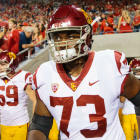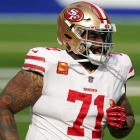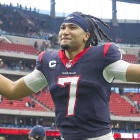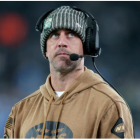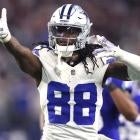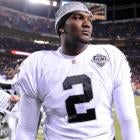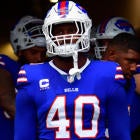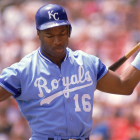In today's NFL, if rookies don't produce instantly, they can be quickly pegged as players who won't ever succeed at the pro level.
But not all have to immediately be stars to ultimately thrive on Sundays. Some, honestly, just need a "redshirt" season.
Below are the players picked in the first or second round of the 2020 NFL Draft who most need time to develop before being thrust into the NFL spotlight.
Disclaimer: For this article, the term "redshirt" isn't exactly meant to have the same definition as it does it college -- a player sitting out an entire season. For a few of these players that could be the case. For others, "redshirt" is simply meant to imply they should have a very limited on-field role in Year 1 as they fine tune their skills and/or add strength in an NFL weight room.
Austin Jackson, OT, Dolphins
Redshirt need: Significant
Likelihood of redshirt: Minimal
In theory, Miami's selection of Jackson in Round 1 was sensible because the Dolphins are a few years away and so is Jackson. At 6-foot-5 and 322 pounds with arms over 34 inches and an explosive combine on his resume, the still-not-21-year-old tackle looks the part. He'll be first off the bus.
But, from a technical standpoint, he's very much a work in progress. Despite his natural girth and length, Jackson is consistently late flashing his hands, which allows defenders to get into his chest and drive him backward into the quarterback. And, often, when he does punch into the chest plate of the oncoming defender, he does so by getting out over his feet, rendering him off balance.
Jackson will be comfy as an on-the-move run/screen blocker right away. But the Dolphins care significantly more about how Jackson protects Tua Tagovailoa than anything else. And while there will be times he'll explode out of his stance and glide step-for-step with an outside speed rush, the youthful USC product simply doesn't have the anchoring power or refined technique to stymie advanced pass rushers on a regular basis in the NFL as a rookie.
As a top 20 selection, and without a viable stand-in on the roster, it's highly unlikely Jackson will be afforded the time he needs to get stronger and hone his fundamentals before getting NFL regular season action.
Cesar Ruiz, OL, Saints
Redshirt need: Moderate
Likelihood of redshirt: Minimal
(Update: A few hours after this article was published, the Saints released Larry Warford. Ruiz is now slated to play either right guard or center as a rookie -- the latter would precipitate a move from center to right guard for Erik McCoy.)
This pick, was, low-key, the strangest selection of 2020's first round. Seriously. The Saints used a second-round pick on center Erik McCoy last year, and he was terrific as a rookie. At Ruiz's penciled in spot in New Orleans -- right guard -- the Saints got a steady season out of veteran Larry Warford in 2019. And, by the way, Ruiz strictly played center at Michigan over the past two seasons.
So Ruiz's skills are not to blame for his moderate need for a redshirt season. It's because he'll be playing a new position in the NFL. For the guard spot, Ruiz is a phenomenal athlete ready to rock at the second level for the ground game. But at 6-3 and 307 pounds, he could stand to pack on some weight to deal with power interior rushers in the NFL. At times in college, he played a tad high and got out-leveraged in pass protection.
Despite all of this, there's a chance Ruiz won't even play immediately, unless the Saints cut/trade Warford before the start of the season. So he might get some redshirt time. Altogether, a nimble, powerful blocker placed into a weird situation in the pros.
Jordan Love, QB, Packers
Redshirt need: Significant
Likelihood of redshirt: Significant
Love truly has all the tools of a new-age franchise quarterback. He can flick it 40 yards downfield with ease, is capable of ripping the ball through tight windows without perfect footwork, and there's plenty of athleticism to create with his legs.
However, he needs to get much better reading and reacting to diverse coverages. Even in 2018, when he completed 64% of his passes with 32 touchdowns and just six picks, a chunk of his impressive production came by way of easy, high-percentage tosses and yards after the catch.
Without those playmakers at Utah State in 2019, Love was asked to do more by way of being a downfield passer, and the interception figure went up. He wasn't helped by his receivers often, and his line was more leaky, but there's no question he repeatedly forced the football into precarious situations. Sometimes it paid off. Many times it didn't. And his accuracy isn't a major concern. It's simply an inability, right now, to read the leverage of coverage defenders or notice linebackers and corners sitting underneath throws he tries to laser to the intermediate level. There's no way he's playing 2020 -- barring injury -- yet 2021 isn't out of the question.
What's good for Love is that Aaron Rodgers is stylistically similar to him. But it doesn't appear as though Rodgers will be a legitimate mentor.
Kenneth Murray, LB, Chargers and Jordyn Brooks, LB, Seahawks
Redshirt need: Moderate
Likelihood of redshirt: Minimal
I'm grouping these two linebackers at the bottom of this list because of their comparable styles, and the fact that they will be fascinating case studies for the state of the position in today's NFL.
They're both big, long, ultra-athletic, hyper-aggressive tackling machines who made a plethora of splash plays behind the line of scrimmage in 2019. Sideline-to-sideline range is not a concern. Neither is hesitation. They're see-ball, get-ball linebackers who play with no wasted motion and are incredible when flying downhill..
The problem though? They're unfathomably raw in coverage. And I mean, raw with their skills and flat-out inexperienced sinking in zone or running with tight ends down the seam. They just didn't do either of those things often at all and barely had any ball production in coverage in college. Murray didn't have an interception at Oklahoma and defended six passes in three years. Brooks picked one pass and had one pass breakup over the past two seasons. And it's all strange because they're coming from the wide-open, pass-addicted Big 12 conference.
Currently, we know how valuable stellar coverage linebackers are, as the NFL leans more toward the pass every year. However, it's intriguing that the defensive coordinators for Murray and Brooks decided to use their extraordinary athletic gifts for QB spy and blitzing roles instead of asking them to drop in coverage.
And the Big 12 has had a major impact on the NFL offensively of late. Maybe adapting a few Big 12 defensive principles is the logical next step for NFL defenses? If so, Murray and Brooks could very well usher in the new era of what a star linebacker will look like in the pros. But in "normal" linebacker roles as rookies on passing plays, they're likely to look completely out of sorts often.









